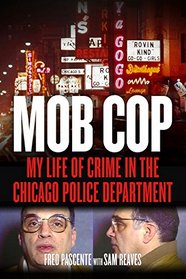Mob Cop: My Life of Crime in the Chicago Police Department
by
Review by jjares
Fred Pascente grew up in the Italian section of Chicago (called the Near West Side) with a wide range of men who emerged as heavy hitters in the Mafia. One of Fred’s closest friends was Tony Spilotro, the youngest made man in the Chicago Outfit History.
A word of explanation: The Chicago Outfit was an Italian-American organized crime family based in Chicago. It originated on the city’s South Side in the early 1910s. The Chicago group was part of the larger Italian-American Mafia. Big Jim Colosimo (aka Diamond Jim or Big Jim) created his Chicago criminal empire through gambling, prostitution, and racketeering. Their rivals were other Chicago gangs, notably the North Side Gang (Al Capone) and the Irish Mob (famously led by Charles Dean O’Banion).
Many of the youngsters Fred grew up with settled into careers in organized crime. However, Fred took a different route. He was drafted into the army and later became a Chicago cop.
The description of the Chicago police on the take and how widespread it was, was sobering. At this time, the city police were poorly paid and took bribes to augment their salaries. Finally, during the 1968 Democratic Convention in Chicago, Mayor Daley gave the city police a $2000/year raise (because Vietnam protestors used the Convention to create violent riots and attack police). According to Fred (a new recruit at the time of the Convention and violence), Mayor Daley told the troops to go after the rioters. After three days of violence against the police (and not allowed to push back), the police were ready to retaliate, and they did. Fred says that history states that the police did the rioting; he disagrees.
During the week, Fred was a policeman; on the weekends, he traveled to Las Vegas with friends. He learned how to rob the casinos while playing cards. Before it was all over, Fred was one of thirty men banned from Las Vegas for life (via Nevada’s casino Black Book). Entering the city again would be a felony for any of the thirty involved.
Fred was soon chosen by William Hanhardt, the chief of detectives in the Chicago Police Dept., because of his connections. Hanhardt turned Fred into his bagman and fixer for several years.
Fred was a policeman for 26 years. He retired just before the FBI indicted him. The FBI wanted William Hanhardt and leaned on Fred. He refused to tell on his friend. Therefore, the police indicted and convicted Fred of insurance fraud (which he’d done with a Gypsy friend). The end of the case resulted in Fred losing his pension. When Fred emerged from prison, he had to start over again. He was still working at 72 when he died.
At first, I was stunned by the blase way Fred talked about crime; before long, the reading was addictive. Fred comes across as an easy-come-easy-go person with a relaxed moral compass. Amazingly, I was disappointed when the book ended.




